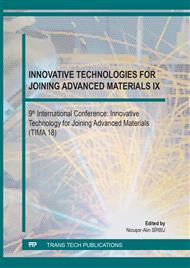[1]
N. Bachschmid, P. Pennacchi, E. Tanzi, Cracked Rotors - A Survey on Static and Dynamic Behaviour Including Modelling and Diagnosis, Springer Heidelberg-Berlin, (2010).
DOI: 10.1007/978-3-642-01485-7
Google Scholar
[2]
W. Braitsch, H. Haas, Turbines for hydroelectric power, In: K. Heinloth (ed), Landolt-Börnstein, Group VIII: Advanced Materials and Technologies, Vol. 3: Energy Technologies, Subvol. C: Renewable Energies, Springer Verlag, Heidelberg-Berlin, 2006, pp.493-604.
DOI: 10.1007/10858992_8
Google Scholar
[3]
D. Momčilović et al.: Failure Analysis of Hydraulic Turbine Shaft, Engineering Failure Analysis, Published by Elsevier, Volume 20, (2012) 54-66.
DOI: 10.1016/j.engfailanal.2011.10.006
Google Scholar
[4]
GOST 977-88, Steel Catings. General Specification.
Google Scholar
[5]
W. R. Revie, H.H. Uhlig, Corrosion and corrosion control. John Wiley & Sons, Inc; (2008).
Google Scholar
[6]
R.P. Gangloff. Corrosion fatigue cracking, In: R. Baboian ed, Corrosion tests and standards: application and interpretation [2nd ed.].ASM International; 2005. p.302–21.
DOI: 10.1520/mnl11032m
Google Scholar
[7]
P. P. Milella, Fatigue and Corrosion in Metals, Springer-Verlag Italia, (2013).
Google Scholar
[8]
I. Atanasovska, R. Mitrović, and D. Momčilović, FEM model for calculation of Hydro turbine shaft, in: Proceedings – the Sixth International Symposium KOD 2010, Palić, Serbia, pp.183-188, (2010).
Google Scholar
[9]
D. Momčilović, A. Subić, I. Atanasovska, R. Mitrović, Combined Load Simulation vs Component Loads Simulation in Machine Design–a Case Study, FME Transactions, Faculty of Mechanical Engineering, University of Belgrade, (2014) 48-55.
DOI: 10.5937/fmet1401048m
Google Scholar
[10]
R. Mitrović, D. Momčilović, I. Atanasovska, Assessment of the Effect of Pitting Corrosion on Fatigue Crack Initiation in Hydro Turbine Shaft, Advanced Materials Research, In A. Subić,: Advances in Engineering Materials, Product and Systems Design (Special topic volume with invited peer reviewed papers only), Trans Tech Publications, Switzerland, (2013) pp.186-196.
DOI: 10.4028/www.scientific.net/amr.633.186
Google Scholar
[11]
D. Momčilović, R. Mitrović, I. Atanasovska, T. Vuherer, Methodology of determination the influence of corrosion pit on decrease of hydro trubine shaft fatigue life, Journal Machine Design, Published by University of Novi Sad, Faculty of Technical Sciences, Vol. 4 No.4, (2012) pp.231-236.
Google Scholar
[12]
G. Sabnavis, G. Kirk, M. Kasarda, D. Quinn, Cracked Shaft Detection and Diagnostics: A Literature Review, The Shock and Vibration Digest, (2004) 287-296.
DOI: 10.1177/0583102404045439
Google Scholar
[13]
L. K. Keppas, L.K., Combination of simulation and experiment in designing repair weld strategies: A feasibility study, Nuclear Engineering and Design 240, (2010) 2897–2906.
DOI: 10.1016/j.nucengdes.2010.05.034
Google Scholar
[14]
W. Janssen, Welding on Rotors for Power Plant Turbo Sets State of the Art, Siemens (2006).
Google Scholar
[15]
A. Aloraier, A. Almazrouee, J.W.H. Price, Weld repair practices without post weld heat treatment for ferritic alloys and their consequences on residual stresses: A review, International Journal of Pressure Vessels and Piping v. 87(4), (2010) 127-133.
DOI: 10.1016/j.ijpvp.2010.02.001
Google Scholar
[16]
A.K. Bhaduri, S.K. Albert, B. Raj, Robust welding technologies for ferrous alloys: Weld Cracking in Ferrous Alloys, Woodhead Publishing, (2009) 34-95.
DOI: 10.1533/9781845695453.1.34
Google Scholar
[17]
Y. Ito, K. Bessyo: Weldability formula of high strength steels, related to heat-affected zone cracking. Sumitomo Search, and IIW-Doc IX-631-69(1969),1-18.,1 (1969), 5, pp.59-70.
Google Scholar
[18]
N. Yurioka, et. al.: Study on carbon equivalents to assess cold cracking tendency and hardness in steel welding; Australian Weld. Res. Ass. Melbourne 19.-20.03.81, (1981) 1-18.
Google Scholar
[19]
N. Yurioka, N., M. Okumura, T. Kasuya and H. J. U. Cotton: Prediction of HAZ Hardness of Transformable Steels. Metal Construction (1987), 217R - 223R.
Google Scholar
[20]
I. Hrivnak, Theory of Weldability of Metals and Alloys, Elsevier Science Publishers, , ISBN 0-444-98707-X, Amsterdam, (1991).
Google Scholar
[21]
Odanovic et al, Selection of the optimal filler material for on-site welding of the turbine shaft at the hydropower plant, Welding and welded structures, No, 4, (2011) 149-166.
Google Scholar
[22]
T. Boellinghaus, J.C. Lippold, C.E. Cross, Cracking phenomena in welds IV, Springer International Publishing, Switzerland (2016).
DOI: 10.1007/978-3-319-28434-7
Google Scholar
[23]
J.L. Meseguer-Valdenebro, J.L. et al.: Calculation of Δt8/5 by Response Surface Metthodology for Electric Arc Welding , Thermal Science 18 (2014), Suppl. 1, p. S149 - S158.
Google Scholar
[24]
V.N. Lazic, V. N., Theoretical-Experimental Determining of Cooling Time (T(8/5)) in Hard Facing of Steels for Forging Dies, Thermal Science, 14,(1), (2010) p.235–246.
DOI: 10.2298/tsci1001235l
Google Scholar
[25]
A. Hobbacher, Recommendations for fatigue Design of SWelded Joints and Components, , IIW document IIW-1823-07, (2008).
DOI: 10.1007/978-3-319-23757-2
Google Scholar
[26]
H. Petershagen, IIW Recommendations on the Repair of Fatigue-Loaded Welded Structures. IIW document. XIII-1632-96, (1996).
Google Scholar
[27]
J. Krebs, M. Kassner, Influence of welding residual stresses on fatigue design of welded joints and components. IIW document XIII-2126-06/XV-1220-06, (2006).
DOI: 10.1007/bf03266586
Google Scholar


